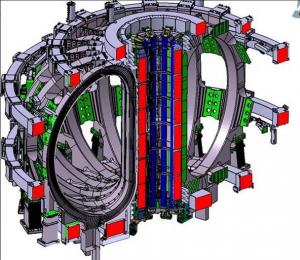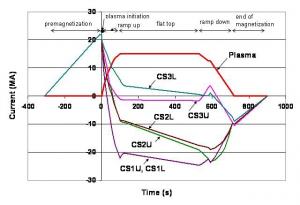Packing a punch
There's an electromagnet in the centre of the ITER Tokamak—eighteen metres tall, four metres wide and one thousand tonnes—that has been designed to pack a terrific punch.
The ITER central solenoid will take advantage of every bit of space from its central position in the machine—right up to the ten millimetres of radial clearance it shares with the surrounding toroidal field magnet system—to achieve the highest value of stored magnetic energy possible.
The central solenoid is the key component that will allow a powerful current to be induced in the ITER plasma and maintained during long plasma pulses.
Two parameters that are important to obtaining maximum plasma current drive are magnetic field and the area of the solenoid. The higher the magnetic field and the larger the area of the magnet where it exists, the greater the magnetic flux, the quantity that characterizes current drive capability.
The ITER central solenoid—with a diameter of 4.3 metres and a height of 18 metres—will top the charts as the largest solenoid ever built for a fusion device. Maximum field of 13 tesla will be reached in the centre of the central solenoid. That's the strongest of all ITER magnet systems, and equivalent to 280,000 times the magnetic field of the Earth.
Solenoids are lengths of coiled wire that generate magnetic fields when electric current is passed through them. Electricity and magnetism are closely related: place two solenoids one inside the other, and the variation of electrical current in the first will produce a variation of electrical current in the second.
ITER and other tokamaks essentially act as large transformers, where the central solenoid is the primary winding, and the plasma the secondary winding.
Solenoids are responsible for driving the plasma current in all tokamak devices. At the largest currently-operating tokamak (JET in the UK), the solenoid initiates plasma currents of about 5 megaamperes (MA) for plasma pulses lasting up to 60 seconds. The plasma volume in ITER will be eight times greater than in JET, and consequently the "drive" required from the central solenoid will be much greater as well. Stored magnetic energy of 6.4 GJ in the central solenoid will initiate and sustain a plasma current of 15 MA for durations of 300-500 seconds.
But the role of the central solenoid doesn't end there. As the high-intensity current circulates within the tokamak, electrons and ions in the plasma will become energized and collide. Collisions create 'resistance' that produces heat. This heating effect, known as ohmic heating, will contribute to bringing the ITER plasma to the temperatures close to 150 million degrees Celsius necessary for fusion to take place.
The central solenoid will also assist in shaping the plasma. Physicists prefer a D-shaped plasma to a circular one; by 'tweaking' current applied to the top and bottom central solenoid modules (see below), operators will use variations in magnetic field to elongate the cross section of the ITER plasma and achieve this optimum shape.
The "central" solenoid is indeed central to the success of ITER operation. Its combination of performance parameters makes it one of the most complex and challenging magnet systems ever built. Strong team effort will be required from all parties throughout the design, fabrication and assembly process.
The "electrical ballet" of the central solenoid
In order to induce powerful current in the plasma, the ITER central solenoid will have to carry a lot of current—46 kA to be precise.
During "ramp-up" at the beginning of an experiment in ITER, voltage will be applied to the six central solenoid modules until they each reach 40 kA of current. This "pre-magnetization' period will last for approximately six minutes.
The current will then be discharged to initiate a plasma pulse. From this moment—until the end of the cycle—the six central solenoid modules will act independently, each following an individual current profile. In certain modules, current will drop to zero directly, before being ramped up again in the reverse direction; others will decrease more progressively; still others will change current directions twice. Only the two central modules, CS1U and CS1L, act as a pair. Toward the end of the cycle, maximum current of 46 kA is reached in some modules.
These variations in current between the different modules give scientists the tool they need for plasma shaping. Current variation, which induces magnetic flux variation, is the key to producing the large plasma current needed for ITER. "What we want in ITER," says Paul Libeyre, Central Solenoid and Correction Coil Section Leader, "is maximum flux variation to allow long plasma pulses."
A central solenoid with fixed current would never work. "Having the possibility of varying the current differently in each of the six modules allows a lot of different scenarios," Paul explains. "It's like allowing dancers to perform individual choreographies, instead of marching all together like in a military parade."
Operators will also use current variation in the top and bottom modules to influence the shape of the plasma for best performance.
For the duration of each 1,000-second plasma pulse during ITER operation, the ballet of increasing and decreasing voltage will continue in the modules, carefully choreographed to build the plasma current up to a plateau of 15 MA for around 400 seconds, before ramping down again to zero.
30,000 plasma pulses are foreseen for the ITER experimental campaign, during which the central solenoid will be "ramped up" to initiate plasma current and "ramped down" again at the end of each pulse.




